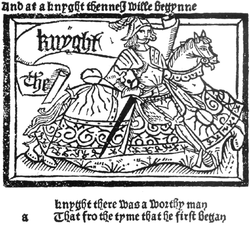
General Prologue
Encyclopedia


The Canterbury Tales
The Canterbury Tales is a collection of stories written in Middle English by Geoffrey Chaucer at the end of the 14th century. The tales are told as part of a story-telling contest by a group of pilgrims as they travel together on a journey from Southwark to the shrine of Saint Thomas Becket at...
. It was the work of 14th century English
England
England is a country that is part of the United Kingdom. It shares land borders with Scotland to the north and Wales to the west; the Irish Sea is to the north west, the Celtic Sea to the south west, with the North Sea to the east and the English Channel to the south separating it from continental...
writer
Writer
A writer is a person who produces literature, such as novels, short stories, plays, screenplays, poetry, or other literary art. Skilled writers are able to use language to portray ideas and images....
and courtier
Courtier
A courtier is a person who is often in attendance at the court of a king or other royal personage. Historically the court was the centre of government as well as the residence of the monarch, and social and political life were often completely mixed together...
Geoffrey Chaucer
Geoffrey Chaucer
Geoffrey Chaucer , known as the Father of English literature, is widely considered the greatest English poet of the Middle Ages and was the first poet to have been buried in Poet's Corner of Westminster Abbey...
.
Synopsis
The frame storyFrame story
A frame story is a literary technique that sometimes serves as a companion piece to a story within a story, whereby an introductory or main narrative is presented, at least in part, for the purpose of setting the stage either for a more emphasized second narrative or for a set of shorter stories...
of the poem, as set out in the 858 lines of Middle English
Middle English
Middle English is the stage in the history of the English language during the High and Late Middle Ages, or roughly during the four centuries between the late 11th and the late 15th century....
which make up the general prologue, is of a religious pilgrimage. Chaucer is in the Tabard Inn
The Tabard
The Tabard, an inn that stood on the east side of Borough High Street in Southwark, was established in 1307, when the abbot of Hyde purchased the land to construct a hostel for himself and his brethren, when business took them to London, as well as an inn to accommodate the numerous pilgrims headed...
, in Southwark
Southwark
Southwark is a district of south London, England, and the administrative headquarters of the London Borough of Southwark. Situated east of Charing Cross, it forms one of the oldest parts of London and fronts the River Thames to the north...
, where he meets a motley crew of middle-class folk from various parts of England. Coincidentally, they are all on the way to Canterbury, the site of the Shrine of Saint
Saint
A saint is a holy person. In various religions, saints are people who are believed to have exceptional holiness.In Christian usage, "saint" refers to any believer who is "in Christ", and in whom Christ dwells, whether in heaven or in earth...
Thomas Becket. In the Prologue, Chaucer seeks to describe their 'condition', their 'array', and their social 'degree':
- To telle yow al the condicioun,
- Of ech of hem, so as it semed me,
- And whiche they weren, and of what degree,
- And eek in what array that they were inne,
- And at a knyght than wol I first bigynne.
The pilgrims include a knight
The Knight's Tale
"The Knight's Tale" is the first tale from Geoffrey Chaucer's The Canterbury Tales. The story introduces many typical aspects of knighthood such as courtly love and ethical dilemmas. The story is written in iambic pentameter end-rhymed couplets.-Story:...
, his son a squire, the knight's yeoman (who maintains numerous resemblances to Robin Hood), a prioress
The Prioress's Tale
"The Prioress's Tale" follows The Shipman's Tale in Geoffrey Chaucer's The Canterbury Tales. Because of fragmentation of the manuscripts, it is impossible to tell where it comes in ordinal sequence, but it is second in group B2, followed by Chaucer's Tale of Sir Topas...
accompanied by a second nun and the nun's priest, a monk, a friar, a merchant, a clerk, a sergeant of law, a franklin, a haberdasher, a carpenter, a weaver, a dyer, a tapestry weaver, a cook, a shipman
The Shipman's Tale
The Shipman's Tale is one of The Canterbury Tales by Geoffrey Chaucer.It is in the form of a fabliau and tells the story of a miserly merchant, his avaricious wife and her lover, a wily monk...
, a doctor of physic
The Physician's Tale
The Physician's Tale is one of the Canterbury Tales written by Geoffrey Chaucer in the 14th century.This is a domestic drama about the relationship between a daughter and her father and it is one of the earliest extant poems in English about such subjects and relationships...
, a wife of Bath, a parson, his brother a plowman, a miller, a manciple, a reeve
The Reeve's Tale
"The Reeve's Tale" is the third story told in Geoffrey Chaucer's The Canterbury Tales. The reeve, named Oswald in the text, is the manager of a large estate who reaped incredible profits for his master and himself. He is described in the Tales as skinny and bad-tempered. The Reeve had once been...
, a summoner, a pardoner, the host (a man called Harry Bailly), and a portrait of Chaucer himself. The order the pilgrims are introduced places them in a social order, describing the nobility in front, the craftsmen in the middle, and the peasants at the end. A canon and his yeoman later join the pilgrimage and tell one of the tales.

